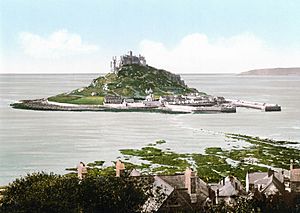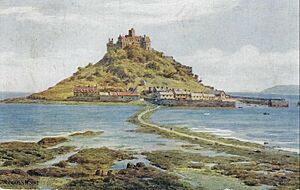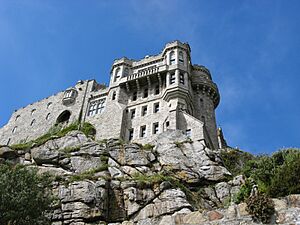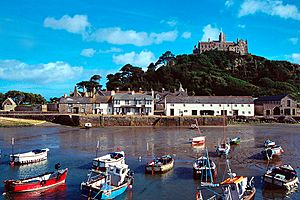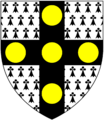St Michael's Mount facts for kids
Quick facts for kids St Michael's Mount
|
|
|---|---|
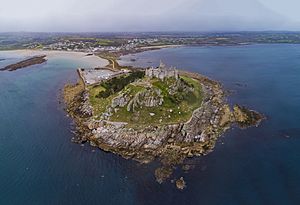 St Michael's Mount |
|
| Lua error in Module:Location_map at line 530: Unable to find the specified location map definition: "Module:Location map/data/Cornwall (mainland)" does not exist. | |
| Area | 0.09 sq mi (0.23 km2) |
| OS grid reference | SW514298 |
| • London | 290 miles (467 km) |
| Civil parish |
|
| Unitary authority | |
| Ceremonial county | |
| Region | |
| Country | England |
| Sovereign state | United Kingdom |
| Post town | MARAZION |
| Postcode district | TR17 |
| Dialling code | 01736 |
| Police | Devon and Cornwall |
| Fire | Cornwall |
| Ambulance | South Western |
| EU Parliament | South West England |
| UK Parliament |
|
| Website | |
|
Listed Building – Grade I
|
|
| Designated | 9 October 1987 |
| Reference no. | 1143795 |
| Designated | 11 June 1987 |
| Reference no. | 1000654 |
St Michael's Mount (called Karrek Loos yn Koos in Cornish, meaning "grey rock in woodland") is a special tidal island in Mount's Bay, Cornwall, England. It's called a tidal island because you can walk to it from the mainland when the tide is low. A path made of granite stones connects it to the town of Marazion.
The island is looked after by the National Trust. The castle and chapel on the island have been home to the St Aubyn family since the 1650s. St Michael's Mount is similar to Mont-Saint-Michel in France, which is also a tidal island with a cone shape. It is one of 43 tidal islands in Great Britain that you can walk to.
Contents
What's in a Name?
The Cornish name, "the grey rock in a wood," might tell us something about how the area looked a very long time ago. Before Mount's Bay was covered by the sea, the island might have been surrounded by a forest. People have even seen remains of trees on the beach at Perranuthnoe during very low tides after storms.
Ancient Times
People lived in this area a very long time ago, between 4000 and 2500 BC. An important discovery was a flint arrowhead found on the lower eastern side of the mount. Other flint pieces have also been found.
During these ancient times, Britain was still connected to mainland Europe. The mount was likely a dry area surrounded by a marshy forest. Any early camps would probably have been destroyed by later building work.
Later, around 1700 BC, a hazel wood forest became covered by the sea. The mount might have been a place where people traded tin. Some people think it could be the island of Ictis, a tin trading center mentioned by an ancient Greek historian.
A Look Back in History
St Michael's Mount might have had a monastery from the 700s to the early 1000s. An English king, Edward the Confessor, gave the site to a religious group from Mont-Saint-Michel in France. It was a smaller monastery (a priory) until the 1400s.
The mount was a popular place for pilgrims (people on a religious journey). The earliest buildings on the top, including a castle, were built in the 1100s.
Battles and Owners
Over the centuries, St Michael's Mount was involved in many conflicts.
- In 1193, Sir Henry de la Pomeroy took the Mount for Prince John.
- The monastery buildings were built in the 1100s.
- In 1424, a monastery called Syon Abbey took over the Mount.
- Later, John de Vere, 13th Earl of Oxford, held the Mount against King Edward IV's soldiers for 23 weeks in 1473–74.
- Perkin Warbeck, who pretended to be an English prince, took the Mount in 1497.
- Humphrey Arundell, the Governor of St Michael's Mount, led a rebellion in 1549.
- During the time of Queen Elizabeth I, the Mount was given to Robert Cecil. His son later sold it to Sir Francis Bassett.
- During the English Civil War, Sir Arthur Bassett held the Mount against the Parliament until 1646.
In 1659, the Mount was sold to Colonel John St Aubyn. His family, the Lords St Levan, still live at St Michael's Mount today.
Life in the Village
We don't know much about the village on the island before the 1700s. There were just a few fishermen's cottages and homes for the monks. After the harbour was improved in 1727, St Michael's Mount became a busy seaport.
In 1755, a huge tsunami (a giant sea wave) caused by the Lisbon earthquake hit the Cornish coast. The sea rose 6 feet (1.8 meters) in 10 minutes at St Michael's Mount and kept rising and falling for five hours.
By 1811, there were 53 houses and four streets. The pier was made longer in 1821. The most people ever lived on the island in 1821, with 221 residents. There were schools, a chapel, and pubs for visiting sailors. But when the nearby Penzance harbour improved and the railway reached Penzance, the village became less important. Many houses were taken down.
The Underground Railway
A short, underground narrow gauge railway was built around 1900. It was used to carry goods up to the castle and take away rubbish. This railway is still used regularly today, but it's not open to the public. It is Britain's last working railway of its kind.
World War II and After
During World War II, the Mount was made stronger to defend against a possible invasion. You can still see three old concrete shelters (called pillboxes) there today.
After the war, a large battleship, HMS Warspite, was brought near the mount to be taken apart.
In 1954, the St Aubyn family gave most of St Michael's Mount to the National Trust. The family still lives in the castle and helps manage how the public can visit its historic rooms.
Protecting the Mount
The chapel of St Michael is a building from the 1400s. It has a tower with battlements, and a small turret that helped guide ships.
Chapel Rock, on the beach, is where a shrine to the Virgin Mary once stood. Pilgrims would stop here to pray before climbing the mount. Inside the castle, you can see many old things like armour, paintings, and furniture.
There are houses built on the hillside facing Marazion. Some of these houses are lived in by staff who work at the castle and on the island. The island also has a cemetery for past residents and sailors who drowned. Other buildings used to be a steward's house, stables, a laundry, and inns.
The harbour was made bigger in 1823 to hold larger ships. Its pier dates back to the 1400s and has been repaired. Both Queen Victoria (in 1846) and Edward VII visited the Mount, and you can see brass marks of their footsteps. In 1967, the Queen Mother also visited.
The path (causeway) between the mount and Marazion was improved in 1879. It was repaired again in 2016 after being damaged by storms. Some studies suggest that rising sea levels could put parts of the Cornish coast, including St Michael's Mount, at risk.
Island Rocks
The rocks around St Michael's Mount show many interesting features of Cornwall's geology (the study of rocks and Earth's history). The mount is made of granite that pushed its way into older rocks called mudstones. Because of its special rocks, the island's seaward side has been a Site of Special Scientific Interest since 1995.
There are two types of granite on the mount. The granite also contains special minerals like tin and tungsten.
Old Stories and Legends
St Michael's Mount might have been a port for the tin trade in ancient times.
There's a popular story that the Archangel Michael appeared to local fishermen on the mount in the 400s AD. However, this story is actually a modern myth.
An old record from 1099 says that St Michael's Mount was once several miles from the sea and surrounded by a thick wood. But then, a great flood covered the land, destroying towns and drowning many people and animals. This fits with the Cornish legend of Lyonesse, an ancient kingdom said to have been swallowed by the sea.
In the 1600s, the writer John Milton used the Mount in his famous poem "Lycidas." The poem talks about the Archangel Michael sitting in a stone chair at the top of the Mount, watching over the sea and protecting England.
Jack the Giant Killer
According to legend, before the castle was built, the island was home to a huge 18-foot giant named Cormoran. He lived in a cave and stole treasures, scaring the local towns and villages. He loved to eat cattle and children!
But a brave young farmer's son named Jack decided to stop him. Jack tricked the giant into falling into a hidden pit and then killed him with his axe. When Jack returned home, the villagers cheered him and called him "Jack the Giant Killer".
Images for kids
See also
 In Spanish: St Michael's Mount para niños
In Spanish: St Michael's Mount para niños
- St Aubyn family
- Mont-Saint-Michel, France
- Cormoran
- Skellig Michael


